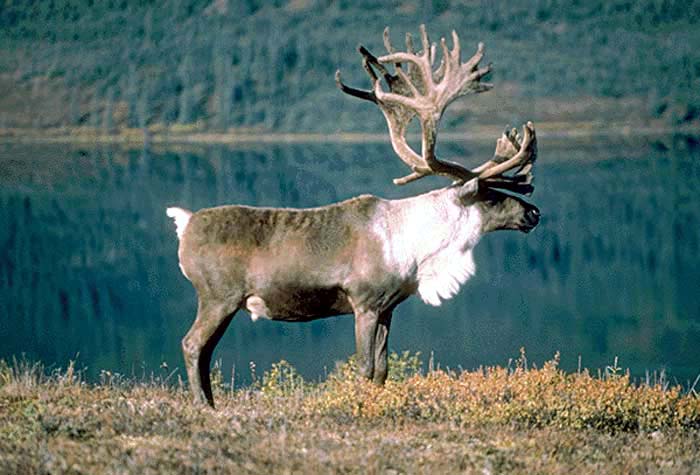
Reindeer, or caribou(Rangifer tarandus)
Phylum —chordata
Class — mammalia
Order — artiodactyla
Family — cervidae
Genus – rangifer
Appearance
The females usually measure 162–205 cm (64–81 in) in length and weigh 80–120 kg (180–260 lb). The males (or "bulls" as they are often called) are typically larger, measuring 180–214 cm (71–84 in) in length and usually weighing 159–182 kg (351–401 lb).
The colour of the fur varies considerably, both between individuals and depending on season and subspecies. Northern populations, which usually are relatively small, are whiter, while southern populations, which typically are relatively large, are darker.
In most populations both sexes grow antlers; the reindeer is the only cervid species in which females grow them as well as males.There is considerable variation between subspecies in the size of the antlers, but on average the bull reindeer's antlers are the second largest of any extant deer, after the moose. In the largest subspecies, the antlers of large males can range up to 100 cm (39 in) in width and 135 cm (53 in) in beam length.
Habitat
Is a species of deer with circumpolar distribution, native to Arctic, sub-Arctic, tundra, boreal, and mountainous regions of northern Europe, Siberia, and North America.
Behavior
Reindeer are social animals. They graze in huge herds in which there may be thousands of heads, and when migrating the herd reaches the quantity of tens of thousands.
Reindeer herds have been migrating along the same route for decades. They can travel five hundred kilometers or more. Animals swim well, so they can easily cross rivers and straits.
Diet
Reindeer are ruminants, having a four-chambered stomach. They mainly eat lichens in winter. However, they also eat the leaves of willows and birches, as well as sedges and grasses.
They have been known to eat their own fallen antlers, probably for calcium. There is also some evidence to suggest that on occasion, especially in the spring when they are nutritionally stressed, they will feed on small rodents (such as lemmings), fish and bird eggs. Reindeer herded by the сhukchis have been known to devour mushrooms enthusiastically in late summer.
Reproduction
Reindeer mate in late September to early November and the gestation period is about 228–234 days. During the mating season, males battle for access to females. Two males will lock each other's antlers together and try to push each other away. The most dominant males can collect as many as 15–20 females to mate with. A male will stop eating during this time and lose much of his body reserves.
To calve, females travel to isolated, relatively predator-free areas such as islands in lakes, peatlands, lakeshores, or tundra. As females select the habitat for the birth of their calves, they are more wary than males. Newborns weigh on average 6 kg (13 lb). After 45 days, the calves are able to graze and forage, but continue suckling until the following autumn when they become independent from their mothers.
The average life of the reindeer is usually from 12 to 15 years.
In captivity
The diet of this type of an animal is standard, as well as for ordinary domestic cattle. To keep the reindeer, it is recommended to choose areas that can feed the whole herd throughout the year. In summer, the animals feed on almost everything that grows in the tundra and tundra forests. In winter, the food consists mainly of yagel, which the animals take out from under the snow.
 Russian
Russian
 English
English























